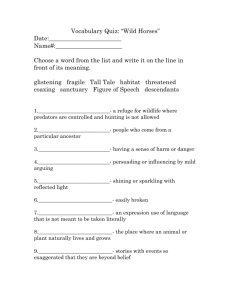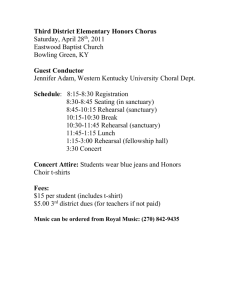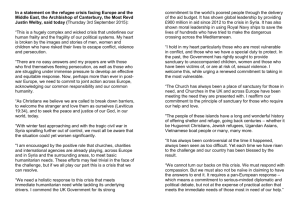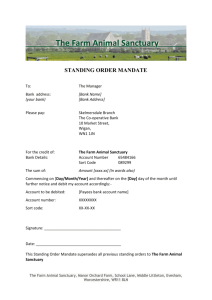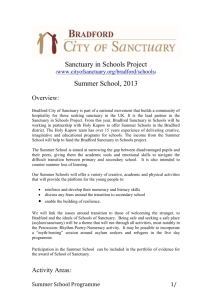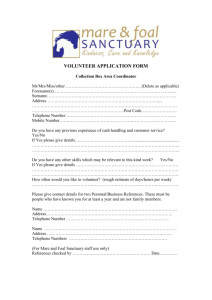Legal and Biblical Myths about the Practice of
advertisement
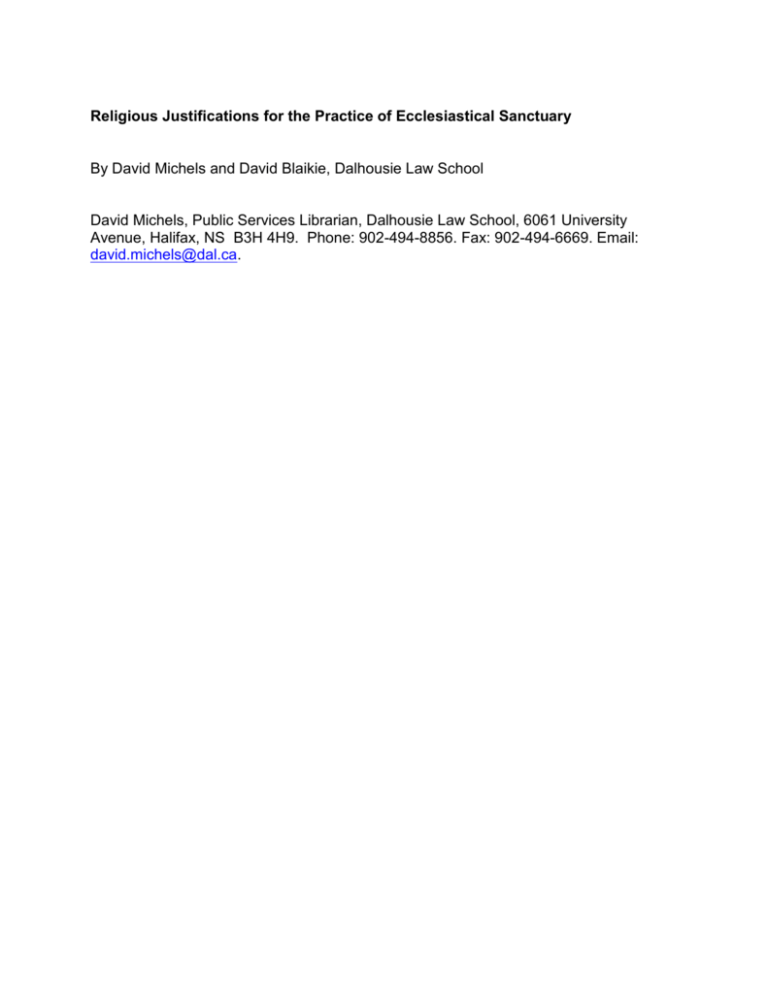
Religious Justifications for the Practice of Ecclesiastical Sanctuary By David Michels and David Blaikie, Dalhousie Law School David Michels, Public Services Librarian, Dalhousie Law School, 6061 University Avenue, Halifax, NS B3H 4H9. Phone: 902-494-8856. Fax: 902-494-6669. Email: david.michels@dal.ca. Religious Justification for the Practice of Ecclesiastical Sanctuary Ecclesiastical sanctuary is defined by the OED as “a church or other sacred place in which, by the law of the mediæval church, a fugitive from justice, or a debtor, was entitled to immunity from arrest. Hence, in wider sense, applied to any place in which by law or established custom a similar immunity is secured to fugitives.” 1 The practice however is very ancient and many societies had customs that offered a form of sanctuary to fugitives. These practices provided some degree of protection for fugitives accused of a variety of offenses and usually had both religious and judicial elements. These practices were usually governed by laws that prevented abuse both by fugitive and pursuer. The reader is referred to several excellent surveys of the law and practice of religious sanctuary from ancient Greece and Rome to the modern practices in the United States, United Kingdom and Canada.2 However, as Ogilvie notes, “sanctuary has been practiced in almost every society”.3 The Ontario Council of Catholic Bishops has appealed to this reality in arguing that sanctuary should be respected by government: “The decision in conscience to offer sanctuary, which is a decision of last resort, is part of every major faith tradition.”4 There are numerous examples of non-Western sanctuary “sanctuary” s.v. Oxford English Dictionary, 2nd ed. 1989. See Ignatius Bau. This Ground is Holy: Church Sanctuary and Central American Refugees, (New York: Paulist Press, 1985); Carro, Jorge L. “Sanctuary: The Resurgence of an Age-Old Right or a Dangerous Misinterpretation of an Abandoned Ancient Privilege” (1985-86) 54 Cincinnati Law Review 747; Avalon, Victoria J. “The Lazarus Effect: Could Florida’s Religious Freedom Restoration Act Resurrect Ecclesiastical Sanctuary?” (2000) 30 Stetson Law Review 664; and Ogilvie, M. H. “Sanctuary: Common Law and Common Sense”, (2004) 83:1 Canadian Bar Review 230. 3 Ogilvie, Ibid., 233. 4 Ontario Conference of Catholic Bishops, An Act of Conscience: A statement on the proposed refugee movement by the Social Affairs Commission of the Ontario Conference of Catholic Bishops, (June 28, 1993). http://www.occb.on.ca/english/documents.php?f=SanctuaryForRefugees1993.html. 1 2 customs. Urrutia-Aparicio5 in describing the practice of diplomatic asylum in Latin America has identified numerous ancient practices outside of the western tradition which he equates with the practice of ecclesiastical sanctuary. One such practice in preChristian Europe was the Germanic institution of Domfrieheit, the principle of home inviolability.6 There are also similar practices among the pre-conquest peoples in Latin America, North America and the Pacific islands7. Perhaps the most notable is the Hawaiian, Pohonua, or “city of refuge”. Urrutia-Aparicio describes two such cities on the islands. They were as he describes them, “sanctuaries for those who fled from an enemy, the manslayer, those who had transgressed a taboo, the chief or the vilest criminal”8. The Hawaiian custom protected the fugitive from vengeance at the hand of an aggrieved family, similar to the Israelite practice which shall be discussed below. 9 Other examples cited were aboriginal groups of Florida, Georgia, the Carolinas and Virginia who constructed a house or town of refugee for the protection of the manslayer, and other wrongdoers. The Chibcha people appear to have maintained a place of refugee for wrongdoers as a sort of religious penal colony10. Conversely, it is noted that the Mayas, Aztecs and Incas appeared not to practice asylum although Urrutia-Aparicio points out one example of recorded political asylum by the Maya for chiefs of a neighbouring tribe while a revolt was being suppressed.11 Don Richardson wrote about a custom among the Yali peoples of New Guinea where a stone wall enclosed ritual place offered inviolable sanctuary for anyone being pursued by an enemy.12 In the modern context, ecclesiastical sanctuary has been described as the practice of sheltering individuals who have been denied refugee status in churches in an attempt to avoid deportation. Although not a frequent practice, sociologist Lippert (2005) has identified 36 instances of sanctuary in Canada prior to 2003. Between January 2003 5 Carlos Urrutia-Aparicio, Diplomatic Asylum in Latin America, (PhD Thesis, The American University, Washington, 1959). 6 Ibid., 11. 7 Ibid., 12. 8 Ibid. 9 W.F. Frear, Hawaiian Judiciary, (1897) 6 Yale Law Journal 213. 10 Ibid., 13. 11 Ibid. 12 Don Richardson. Eternity in their hearts. Ventura, CA: Regal Books, 1984. and October 2005 there were 11 more reported instances of sanctuary (Interfaith, 2005). The practice occurs across the spectrum of Christian denominations in every part of Canada (Lippert, 2005, p. 392). Yet it remains an illegal practice, undertaken in defiance of Canadian law and policy. There is very limited Canadian legal commentary on the status of the practice of ecclesiastical sanctuary in Canada. This is best accounted for by Prof. Ogilvie, “To entertain the obviously demented notion that sanctuary may have survived in the common law into the 21st century as some kind of private jurisdiction, albeit temporary, enjoyed by the Christian churches at least, is to risk being thought mad, and certainly ignorant of the constitutional revolution of the English reformation….”13 With or without legal status the practice of granting ecclesiastical sanctuary continues in Canada. This article will examine several key presuppositions used by churches to justify the practice of offering ecclesiastical sanctuary in defiance of Canadian law and will advance conclusions whether these presuppositions are valid. I. Judeo-Christian Theological Foundation for Sanctuary What is the Judeo-Christian theological foundation for the practice of ecclesiastical sanctuary? Surprisingly it was difficult to find a clear articulation of the biblical / theological foundations of the practice in Canada. A thorough search of the ATLA Religion Index: Periodicals for scholarly articles using the search terms “ecclesiastical sanctuary” or “church sanctuary” or “asylum and refugee” found few articles that offered any analysis of the theological underpinnings of the practice. The articles found were largely polemical. Several offered primarily legal analyses of the American sanctuary movement. The underlying theological principles were largely assumed and there was little that reflected on the Canadian context. This lack of scholarly analysis is surprising, given the prevalence of theological justifications for the practice of sanctuary offered by religious leaders and others. 13 Ogilvie, note 2, 229. Perhaps the best discussion was from a Central American scholar, Jon Sobrino, analyzing the American Sanctuary movement of the 1980s14. The American Sanctuary movement focused primarily on Central American refugees from oppressive regimes. Sobrino sets out three theological justifications for the practice: 1) it reflects God’s concern for the poor, 2) it is ethically necessary as reparation, and 3) it is beneficial for both the refugee and receiving nation. The second theological justification reflects the 1980s American context. Sobrino argues that U.S. foreign policies in Central America had created situations of repression from which these refugees are victims. Thus the U.S. is ethically bound to accept these refuges as an act of reparation15. He reminds his American readers that the U.S. was a nation often built by immigrants fleeing oppression. This justification is context specific and is not directly applicable to the Canadian situation. The third justification Sobrino presents is certainly not contested by either side of the Canadian sanctuary debate. Immigration benefits both the refugees and Canada. The question is whether individual applicants denied status should be given sanctuary by a church; how do churches justify taking that step? We shall focus on Sobrino’s first and perhaps most compelling justification. Sobrino writes: “The sanctuary movement is justified theologically because it is a way of defending the lives of the poor and thus of believing and acting out biblical faith. The central theological thesis is as follows: God is the defender of the lives of the poor and that defense is absolute and unconditional; every human being, and especially believers, has the rights and obligation of defending the lives of the poor.”16 Sobrino draws on several Biblical passages to illustrate this principle17. Most speak generally 14 Jon Sobrino, Sanctuary: a Theological Analysis, (1988) 38 Cross Currents 164. Ibid., 169. 16 Ibid., 165. 17 Ibid., 168. 15 about the need to care for the poor and oppressed18. However several of the passages he quotes deal directly with the plight of the sojourner or immigrant19: You will not mistreat nor oppress the emigrant. Exodus 22:20, 23:9 When the emigrant settles with you in your country do not oppress him.” Deuteronomy 10:18ff, 24:17ff. You were emigrants in Egypt. Luke 19:34. Sobrino’s argument is well founded; these examples could be multiplied many times over. There are abundant textual sources in both Jewish and Christian sacred texts and vast commentary over the centuries which draw a clear and strong connection between the teachings of these religions and concern for the poor and oppressed. However, although this justification provides a foundation for the churches’ mandate to act on behalf of refugees it does not go as far as justifying any particular course of action such as the practice of ecclesiastical sanctuary. Churches claim that the offer of sanctuary is part of their faith tradition as embodied in their sacred texts. Are there any specific texts within Jewish and Christian sacred literature that may justify or support this course of action? The most cited conceptual source for the practice of ecclesiastical sanctuary is the Biblical idea of the ārê mīqlāţ, “cities of refuge”. The United Church of Canada’s Guide for Congregations20 for churches considering offering sanctuary writes that in the Western Judeo-Christian tradition the practice “began with God’s directive to Moses to establish ‘six cities of refuge for the Israelites, for the resident or transient alien among See Psalms 86:5 “Father of orphans and widows”, Hosea 14:3 “In You the orphans find compassion”, Luke 6:20 “Blessed are the poor”. 19 Supra note 3, 168. 20 United Church of Canada, The, Sanctuary for Refugees? A Guide for Congregations, 1997. Revised 2004. 18 them, so that anyone who kills a person without intent may flee there.’ (Numbers 35:13, 15)”21 If this is taken as the foundation of the modern practice of ecclesiastical sanctuary then an investigation of the practice rightly begins here. The Anchor Bible Dictionary lists six Biblical texts which make reference to the “cities of refuge”22. These are: Numbers 35:915; Deuteronomy 4:41-43; 19:1-13; Joshua 20; and 1 Chronicles 6. There are three additional texts which describe a related practice which Biblical scholar Bau describes as “altar sanctuary.”23 These are Exodus 21:13, 1 Kings 1:50-53 and 1 Kings 2:28-34. We shall consider each of these passages. In the discussion that follows we first shall consider both the explicit and implicit intents of the practices suggested by the sacred text. Secondly we shall consider the proposed and actual outcomes of these practices and any social and religious commentary on these outcomes provided by the authors and redactors of these texts. II. The Practice of Sanctuary in Judeo-Christian Sacred Texts A. The Sanctuary of the Altar Exodus 21:12-14 "Anyone who strikes a man and kills him shall surely be put to death. However, if he does not do it intentionally, but God lets it happen, he is to flee to a place I will designate. But if a man schemes and kills another man deliberately, take him away from my altar and put him to death.”24 The context of this passage in Exodus is significant as it is included in a set of directives that address personal injuries. Chp. 19 Moses and the people of Israel arrive at Mount Sinai Chp. 20 Giving of the Decalogue (The Ten Commandments) 21 Ibid., 3. See also Bau, supra note 2 at 124-129 and Carro, supra note 2 at 749-751. Anchor Bible Dictionary, vol. 5, New York: Doubleday, 1992, s.v. “Refuge, Cities of.” 23 Bau, supra, note 9, 127. 24 Excerpts taken from the Holy Bible, New International Version, Grand Rapids, Michigan: Vondervan, 1978. 22 Chp. 21:1 Introduction- “These are the laws you are to set before them.” 21:2-10 Hebrews Servants 21:11-36 Personal Injuries 22:1-15 Protection of Property 22:16-31 Social Responsibility The relevant passage immediately follows Israel’s arrival at Mount Sinai and the first telling of Moses’ Law Code, “the Ten Commandments” in chapter 20. The Law Code in Exodus represents a particular kind of literature, apodictic law, which sets down general prohibitions using the form of the Hebrew lō΄ “not” with the 2nd person masculine singular (thou) or plural (you). Particularly relevant to this discussion is the sixth commandment, “You shall not murder.”25 Chapter 21 begins a collection of casuistic or case law addressing personal injury offenses, beginning with capital offenses (vv 12-17) and then lesser crimes (vv 18-36).26 It is in this chapter that we find the oft quoted principle of “an eye for an eye, and a tooth for a tooth”.27 These laws use the familiar “if/then” formula setting out both the contexts that define transgressions and the penalties for transgressing. In Exodus 21:12a we find the directive to execute the murderer echoing the Genesis 9:6 pronouncement: “Whoever sheds the blood of man, by man shall his blood be shed….” In the Genesis context it is uncertain if this was legal or proverbial statement.28 The Exodus account does appear to prescribe some form of retribution. The Eerdmann’s Dictionary of the Bible describes how the sentence was carried out: “In ancient Israel, as elsewhere in the ancient Near East, blood vengeance was accepted as a means of dealing with the shedding of blood outside of the context of war. If a family member was killed, it was the responsibility of the gô’ēl haddām, “avenger of blood”, a male relative 25 Ibid., Exodus 20:13. John I. Durham, Exodus, Word Biblical Commentary, Waco, Texas: Word Books ,1987, 322. 27 Exodus 21:24a. 28 Gordon Wenham. Genesis 1-15, Word Biblical Commentary, Waco: Word Publishers, 1987, 193. 26 to find and kill the person who had taken the life of the family member….”29 Biblical law did allow for alternative punishments for many offenses but in the case of premeditated murder there could be no alternate since there have been a transgression against the image of God.30 This underscores the seriousness of the offense. But the passage goes on to describe a limitation on this practice: “However, if he does not do it intentionally, but God lets it happen, he is to flee to a place I will designate.” De Vaux, a specialist in ancient Israel’s religious and civil institutions suggests the reason for this limitation: “The very ancient custom of blood-vengeance, carried out by the go’el never disappeared and was recognized by law. But the same law tried to limit the abuses which could easily arise from this exercise of private justice.”31 There was a distinction made between a malicious and planned act and accidental or unintentional killing. Here we find a form of sanctuary established as protection for the unintentional killer. This passage sets out that there would be a place of safety designated, likely a place of worship since an altar is mentioned as being there. However, the protection of the sanctuary was not absolute; if it was determined that the killing was premeditated and not accidental then protection was revoked. The offender would be removed from the sanctuary and executed. Although it is not stated in the passage, it is assumed that the “avenger” would carry out the sentence. The intent then of this directive is to provide protection to the manslayer, but equally to ensure judgment on the murderer.32 In the 1 Kings’ passages we see two examples of this directive. 1 Kings 1 we see David’s son Adonijah, anticipating his father David’s death, setting himself up as king. Eerdman’s Dictionary of the Bible, Grand Rapids, Michigan: Eerdmann’s, 2000, s.v. “Cities of Refuge”. 30 Numbers 35:30-33. See also G.J. Wenham, The Book of Leviticus, New International Commentary on the Old Testament, Grand Rapids, MI: William B. Eerdmans, 312. 31 Ronald de Vaux, Ancient Israel: Its life and institutions, London: Darton, Longman and Todd, 1962, 160. 32 It should be noted that “[t]he idea of asylum is not unique to the Hebrew tradition. Several ancient peoples, in the Ancient Near East and elsewhere, had the idea that fugitives could gain sanctuary by proceeding to or fleeing to certain designated places. Often these places were cultic centers.” Supra, note 11. 29 King David, on his deathbed, anoints his son Solomon as king instead. Word soon reached the pretender king and his partying companions. Fearful of his brother’s wrath, he flees to the sanctuary to claim its protection. The sanctuary is not identified here but it is likely the Tabernacle in Jerusalem.33 “But Adonijah, in fear of Solomon, went and took hold of the horns of the altar.”34 The altar itself was approximately 2.5 feet high by 4.5 feet wide by 4.5 feet long and had a horn on each corner.35 The horns on each corner were used to tie the sacrificial animal to be offered to God. Horned altars appear to have been common in ancient Palestine and have been found in a number of archaeological sites.36 They were particularly sacred and in this context had a symbolic value. Wiseman notes “[t]o grasp them was to claim the protection of God until the case was judged.”37 The custom of asylum was not limited to Israel. Jones argues that the practice was widespread throughout the Ancient Near East and that the custom may have been practiced by the Canaanites in their sanctuaries before the Israelites. 38 King Solomon gave his promise that he would not execute Adonijah for his act of treason if he left the sanctuary altar. The promise was conditional: “Solomon replied, ‘If he shows himself to be a worthy man, not a hair of his head will fall to the ground; but if evil is found in him, he will die.’” This places the responsibility for his life squarely on Adonijah’s shoulders: Solomon will not be guilty of the blood of Adonijah if he violates their agreement. He is allowed to return to his home not as house arrest or banishment but as a free citizen.39 Wiseman makes an additional suggestion here about the wording of Solomon’s 33 D.J. Wiseman. 1 & 2 Kings, Tyndale Old Testament Commentaries, Downers Grove, Ill.: Intervarsity Press, 1993, 74. 34 1 Kings 1:50. 35 Exodus 27:1-2. 36 G.H. Jones. 1 and 2 Kings, Vol. 1, The New Century Bible Commentary, Grand Rapids, MI: Wm. B. Eerdmans, 1984, 105. 37 Supra note 29. 38 Supra note 32. 39 Ibid., 106. command “Go to your home”. He notes that if reconciliation were complete we would have expected the words “in peace” as we find in other passages.40 The situation is not yet resolved. In 1 Kings 2:22-25 we find that after receiving this reprieve Adonijah again made an attempt on the kingship and was subsequently executed by Solomon. When his crime was presumption, Adonijah’s sentence was suspended but when his crime was premeditated and intentional, the sentence of death was carried out. Here altar sanctuary allowed the temporary suspension of judgment and despite the eventual negative outcome provided Adonijah with an opportunity to prove his loyalty and be reconciled. In the story of 1 Kings 2:28-34 Joab, one of King David’s military commanders, was guilty of treason, and the murder of two fellow soldiers. “He killed them”, David declared, “shedding their blood in peacetime as if in battle….”41 Although Joab has escaped punishment thus far, the ascension of Solomon to the throne, and the death of Adonijah, signaled the payment of old debts. When the news reached Joab, who had conspired with Adonijah though not with Absalom, he fled to the tent of the LORD and took hold of the horns of the altar. King Solomon was told that Joab had fled to the tent of the LORD and was beside the altar. Then Solomon ordered Benaiah son of Jehoiada, "Go, strike him down! ... The LORD will repay him for the blood he shed, because without the knowledge of my father David he attacked two men and killed them with the sword. So Benaiah son of Jehoiada went up and struck down Joab and killed him….”42 This passage recalls events from 2 Samuel 2:19-23 and 3:27. In the ongoing conflict between the Houses of David and Saul, Abner, commander of Saul’s army had fought against two of David’s soldiers Asahel and his brother Joab. Abner reluctantly killed Asahel in self defense. Later after the conclusion of the war, we read that “Joab took [Abner] aside into the gateway, as though to speak with him privately. And there, to avenge the blood of his brother Asahel, Joab stabbed him in the stomach, and he died.” 40 Supra note 29, 74; c.f. 2 Kings 5:19. 1 Kings 2:5b. 42 1 Kings 2:28-34. 41 There is an interesting distinction here between killing in war, killing in self defense and premeditated murder. The second killing is recounted in 2 Samuel 20. This also was an assassination of an ally of David in a similar manner, “Joab said to Amasa, ‘How are you, my brother?’ Then Joab took Amasa by the beard with his right hand to kiss him. Amasa was not on guard against the danger in Joab’s hand, and Joab plunged it into his belly, and his intestines spilled out on the ground.”43 Joab’s motivation for this killing has been described as jealousy of Amasa’s place in King David’s court.44 In 1 Kings 2:5-6 we find David’s charge to Solomon to deal with Joab when he became king. It is clear David felt an obligation to avenge the shed blood. Jones writes that the preferable interpretation is “that the guilt for the blood shed by Joab fell upon David, who as king was the person in authority and must ultimately assume responsibility for the affair.”45 It is clear that there was a belief is a royal obligation to ensure justice is done even if in this case it was delayed. In the Kings’ passage, Joab sought out altar sanctuary. However, he was judged as a murderer and the sentence of death was carried out with Joab still clinging to the horns of the altar. B. The Cities of Refuge The next two passages, Numbers 35:9-15 and Deuteronomy 19:1-13 present another development of the practice of altar sanctuary. Here we find what are presented as divine directives to establish “cities of refuge”. Greenberg in the “Biblical Conception of Asylum” suggests two possible reasons for this development. One is that the “altar sanctuary” passages reflect an earlier custom of seeking sanctuary in local religious shrines prior to the later reforms reflected in the Book of Deuteronomy when the “cities of refuge” are established.46 The move to abolish local shrine worship in favour of the 43 2 Samuel 20:9-10a. C.F. Keil and F. Delitzsch, Joshua, Judges, Ruth, 1 and 2 Samuel, Commentary on the Old Testament, vol. 2, Grand Rapids, MI: Wm. B. Eerdmans, 1986, 454. 45 Supra note 32, 108. 46 Moshe Greenberg, “The Biblical Conception of Asylum”, 78 Journal of Biblical Literature 125 at 126. 44 centralized temple worship would have made it essential that an alternative form of sanctuary be created. Alternatively, there is the more practical reason that “the altar, it has been pointed out, cannot have provided a permanent refuge for the manslayer….”47 J. de Vaulx suggests that the passages we are considering identify five stages in the development of this practice with the final being the Joshua account. 48 Certainly as we shall see below this is a movement away from private to public justice. Numbers 35:9-12 “Then the LORD said to Moses: "Speak to the Israelites and say to them: 'When you cross the Jordan into Canaan, select some towns to be your cities of refuge, to which a person who has killed someone accidentally may flee. They will be places of refuge from the avenger, so that a person accused of murder may not die before he stands trial before the assembly.” The Numbers passage is part of a longer text on the subject of murder. Auld divides the chapter into three sections: vv. 1-8 contain the command to establish Levitical cities, the home of the priestly Levite tribe, six of which are described as “cities of refuge”, vv. 9-15 describe the role of these cities, and vv. 16-34 define different kinds of killing.49 The passage and the following verses extends the directive in Exodus by defining murder more specifically and naming (DMMMMM) There are three principles taught here: 1) there was a public obligation to protect the unintentional killer, 2) there was a distinction made between intentional and unintentional killing, and 3) offering sanctuary preserved the accused until a public trial could occur. Philip Budd notes in his commentary on this passage that “…a time of respite would obviously be required if distinctions between murder and manslaughter were to be effective.”50 In Numbers 35:16-34 we see a set of regulations that are intended to guide the judgment of the community51. Significant elements are that the offense must be without malice52, hostility53, foreknowledge54, nor 47 Ibid., 126. J. de Vaulx, Les Nombres, Source Bibliques, Paris: Libraire Lecoffre, 1972, 396-403. 49 A. Graeme Auld, “Cities of Refuge in Israelite Tradition”, 10 Journal for the Study of The Old Testament 26 at 27. 50 Philip J. Budd, Numbers, Word Biblical Commentary, Waco, Texas: Word Books, 1984, 383. 51 Numbers 35:29. 52 Ibid., v. 20. 53 Ibid., v. 22. 54 Ibid., v. 23. 48 intention55. In vv. 25a-28 we see another interesting provision. The accused is required to take up residence in the city even if he is determined not to be a murderer. He is permitted only to leave after the death of the high priest. If he leaves prior to this the avenger of blood may take his life without penalty. It is suggested that this provision is intended to reflect the idea that any shedding of blood, willful or not, ritually defiles the community and only human death, personally or vicariously, can extinguish this guilt.56 Finally in v. 30 we see the requirement of testimony of witnesses to the alleged act of murder be presented at the trial. The passages in Deuteronomy 4:41-43 and 19:1-13 add several additional elements. In 4: 43 we find three cities explicitly named. In 19:3 there is a community obligation to build roads to ensure access to the “cities of refuge”. Joshua 20:4-6 describes the procedure in greater detail: When he flees to one of these cities, he is to stand in the entrance of the city gate and state his case before the elders of that city. Then they are to admit him into their city and give him a place to live with them. If the avenger of blood pursues him, they must not surrender the one accused, because he killed his neighbor unintentionally and without malice aforethought. Joshua, like Numbers, lists cases for which the “city of refuge” is not open (16-21), and applicable cases (22-23)57. The purpose of the “cities of refuge” is again restated at the close of the Joshua account: “Any of the Israelites or any alien living among them who killed someone accidentally could flee to these designated cities and not be killed by the avenger of blood prior to standing trial before the assembly.”58 Biblical scholar Duane Christensen, commenting on Deuteronomy 4, makes an interesting parallel. He writes, “The rights of the individual need to be protected in our society even against legitimate institutions operating within the law. Though we do not have “cities of refuge” in a physical sense, we do have courts of appeal, and a person guilty of manslaughter must enjoy the full benefit of protection until murder can be demonstrated. At the same time 55 Ibid. Supra, note 28, 384. 57 Trent C. Butler, Joshua, Word Biblical Commentary, Waco, Texas: Word Books, 1983, 212-213. 58 Joshua 20:9. 56 the “city of refuge” in ancient Israel was not simply a place of safety. It was a place in which the manslayer made atonement for the deed of which he was guilty.” 59 C. Common Themes and Conclusion Fundamentally, the practices of “altar sanctuary” and the “cities of refuge” were intended to provide a measure of protection to the individual accused of murder and subject to private justice. These practices demonstrated that all life was sacred including that of the accused. These practices recognized the legitimacy of the tradition of private justice through the avenger of blood. These practices both recognized that the killing of a person was not always murder and that there were criteria that had to be met before the judgment of murder was made. Since the crime required the death penalty these processes provided the possibility of appeal to prevent a miscarriage of justice. These processes imposed a community obligation to ensure that the accused had this opportunity to plead his/her case. Yet the offer of sanctuary was conditional. The accused would have the opportunity to a trial where the evidence and testimony would be weighed by the community elders or in the two examples of altar sanctuary, the king. The accused found to be guilty of murder was turned over for execution. Sanctuary ensured due process and provided for a resolution of the conflict. How does the Biblical practice compare to the contemporary practice of ecclesiastical sanctuary? First, both practices are built on the premise that there is a divine directive that all life is sacred and for that reason must be protected. Second, the contemporary practice is perceived to function in the role of an appeal process particularly for those whose lives and personal safety may be in jeopardy, as did the Biblical process. Third, both practices require both a community role and a judicial role in ensuring that justice is done. However, in comparative analysis of two potentially related practices, it is not sufficient to identify similarities; one must also account for discrepancies. Here it becomes evident 59 Duane Christensen, Deuteronomy 1-11, Word Biblical Commentary, Waco, Texas: Word Books, 1991, 98. that although there are similarities in the Biblical and contemporary practices, there are significant differences. First, the Biblical practice addresses individuals accused of a capital offense, which is not the case for refugee claimants. Although the refugee and foreigner were entitled to claim sanctuary, it was a criminal process. Second, the Biblical process as demonstrated above moved the prosecution of murder from a private to a more public matter. Conversely, modern ecclesiastical sanctuary moves the matter of refugee claims from a public and state matter to a private one where a congregation plays the role of the clan/family in the judgment of the “accused”. Additionally, the Biblical claim of sanctuary was part of the system of law and initiated a swift legal proceeding that might see the offer of sanctuary revoked. The contemporary practice functions outside the Canadian system of law and does not initiate a legal proceeding but defies the decision of the judicial process. It does not seem to allow for the possibility of a negative judgment. It does not provide in a significant way for the long-term care of those in sanctuary nor provide opportunities for a resolution of the situation. The dissimilarities are such to allow a strong conclusion that the Biblical practice cannot be the conceptual foundation of the contemporary practice of ecclesiastical sanctuary except as being another, albeit an important and significant, example of the Biblical concern for justice and due process. To claim the Biblical practice of sanctuary as the paradigm for the Canadian practice is to misappropriate a custom for a purpose for which it was never intended or designed. This conclusion however does not preclude the practice on other theological and practical grounds. There are strong theological traditions in both Judaism and Christianity of civil disobedience based on moral grounds. It could be argued that the Biblical texts offer exemplars of civil disobedience that are well known within the most congregational communities. The Hebrew Bible (Old Testament) account of the Hebrew midwives, the account of Daniel and the Lion’s den and the account of Shadrack Meshach and Abednego are familiar stories taught in Church and Synagogue schools. Each account describe an incident where the religious hero refused to comply with a lawful decree from a legitimate authority based on theological considerations. Less well known accounts could be Abram and Sarai and Jacob and Rachel, where the protagonist failed to resist a ruler’s directive. In these accounts, the story describes divine intervention to resolve the crisis and condemnation of the failure to act. A commonly cited New Testament exemplar would be the Acts account with the statement “you judge for yourselves whether it is better to heed the word of God or of men.” I set this apart since though the Sanhedrin had a judicial function, this was is a religious rather than civil role. This was in fact a religious rather than civil or criminal dispute. Anchor Bible Dictionary, vol. 5, New York: Doubleday, 1992. Auld, A. Graeme. “Cities of Refuge in Israelite Tradition”, 10 Journal for the Study of The Old Testament 26. Avalon, Victoria J. “The Lazarus Effect: Could Florida’s Religious Freedom Restoration Act Resurrect Ecclesiastical Sanctuary?” (2000) 30 Stetson Law Review 664. Bau, Ignatius. This Ground is Holy: Church Sanctuary and Central American Refugees, (New York: Paulist Press, 1985); Budd, Philip J. Numbers, Word Biblical Commentary, Waco, Texas: Word Books, 1984. Butler, Trent C. Joshua, Word Biblical Commentary, Waco, Texas: Word Books, 1983. Carro, Jorge L. “Sanctuary: The Resurgence of an Age-Old Right or a Dangerous Misinterpretation of an Abandoned Ancient Privilege” (1985-86) 54 Cincinnati Law Review 747. Christensen, Duane. Deuteronomy 1-11, Word Biblical Commentary, Waco, Texas: Word Books, 1991. de Vaulx, J. Les Nombres, Source Bibliques, Paris: Libraire Lecoffre, 1972 de Vaux, Ronald. Ancient Israel: Its life and institutions, London: Darton, Longman and Todd, 1962 Durham, John I. Exodus, Word Biblical Commentary, Waco, Texas: Word Books,1987. Eerdman’s Dictionary of the Bible, Grand Rapids, Michigan: Eerdmann’s, 2000. Frear, W.F. Hawaiian Judiciary, (1897) 6 Yale Law Journal 213. Greenberg, Moshe. “The Biblical Conception of Asylum”, 78 Journal of Biblical Literature 125. Holy Bible, New International Version, Grand Rapids, Michigan: Vondervan, 1978. Interfaith Sanctuary Coalition “Who is currently in sanctuary?” online: http://www.exponenciel.com/sanctuary/en/cases.htm , Accessed October 20, 2005. Jones, G.H. 1 and 2 Kings, Vol. 1, The New Century Bible Commentary, Grand Rapids, MI: Wm. B. Eerdmans, 1984. Keil, C.F. and F. Delitzsch, Joshua, Judges, Ruth, 1 and 2 Samuel, Commentary on the Old Testament, vol. 2, Grand Rapids, MI: Wm. B. Eerdmans, 1986 Lippert, Randy. “Rethinking Sanctuary: The Canadian Context, 1983-2003” (2005) 39(2) The International Migration Review 381. Moshe Greenberg, “The Biblical Conception of Asylum”, 78 Journal of Biblical Literature 125. Ogilvie, M. H. “Sanctuary: Common Law and Common Sense”, (2004) 83:1 Canadian Bar Review 230. Ontario Conference of Catholic Bishops, An Act of Conscience: A statement on the proposed refugee movement by the Social Affairs Commission of the Ontario Conference of Catholic Bishops, (June 28, 1993). http://www.occb.on.ca/english/documents.php?f=SanctuaryForRefugees1993. html. Oxford English Dictionary, 2nd ed. 1989. Sobrino, Jon. “Sanctuary: a Theological Analysis”, (1988) 38 Cross Currents 164. United Church of Canada, The. Sanctuary for Refugees? A Guide for Congregations, (1997. Revised 2004) http://www.united-church.ca/migration/pdf/sanctuary.pdf. Urrutia-Aparicio, Carlos. Diplomatic Asylum in Latin America, (PhD Thesis, The American University, Washington, 1959). Wenham, Gordon. Genesis 1-15, Word Biblical Commentary, Waco: Word Publishers, 1987. Wenham, Gordon. The Book of Leviticus, New International Commentary on the Old Testament, Grand Rapids, MI: William B. Eerdmans, 1979. Wiseman, D.J. 1 & 2 Kings, Tyndale Old Testament Commentaries, Downers Grove, Ill.: Intervarsity Press, 1993.

